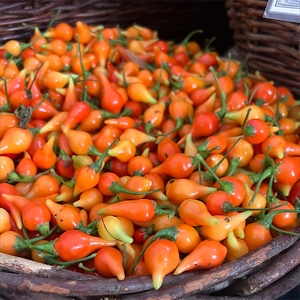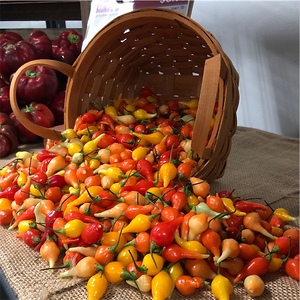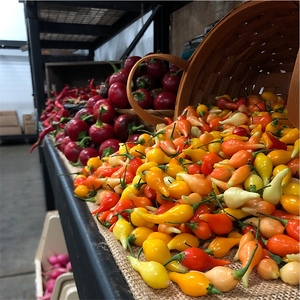


Red Biquinho Peppers
Estimated Inventory, lb : 0
Description/Taste
Red biquinho chile peppers are very small, tear-drop shaped pods, averaging three centimeters in length, and have a curved center that tapers into an elongated, pointed tip. The skin ripens from pale green to bright red when mature and is glossy and smooth, connected to a slender and curved, dark green stem. Underneath the skin, the medium to thick flesh is red, crisp, and aqueous, encasing a very small cavity filled with round and flat, cream-colored seeds. Red biquinho chile peppers are very crunchy and juicy with an initially tangy, citrus taste followed by a sweet, fruity, and slightly smoky flavor reminiscent of habanero peppers. The peppers also contain mild heat that fluctuates in intensity depending on the climate, soil, and environment the pod is grown in.
Seasons/Availability
Red biquinho chile peppers are available in the late summer through early fall.
Current Facts
Red biquinho chile peppers, botanically classified as Capsicum chinense, are uniquely shaped, brightly colored pods that are members of the Solanaceae or nightshade family. Considered to be highly ornamental, Red biquinho chile peppers are not grown on a commercial scale but are commonly found in home gardens in their native country of Brazil. The pods delicately hang from branches on a small, wide-spreading plant, and each plant can produce hundreds of pods throughout the season. Red biquinho chile peppers have a mild heat, ranging 500-1,000 SHU on the Scoville scale and are known for having fruity flavors reminiscent of a habanero pepper without the intense heat. The name biquinho translates to mean “little beak,” which is derived from the pepper’s similarity in appearance to a small pointed bird’s beak, and the small peppers are popularly pickled and served as a bite-sized snack.
Nutritional Value
Red biquinho chile peppers are an excellent source of vitamins A and C and also contain potassium, magnesium, iron, phosphorus, and dietary fiber. In addition to vitamins and minerals, the minimal amount of capsaicin found in the small peppers provides some anti-inflammatory properties.
Applications
Red biquinho chile peppers are best suited for both raw and cooked applications such as stir-frying, sautéing, and baking. When utilized fresh, the peppers can be chopped into salsas, blended into sauces and marinades, or sliced and tossed into salads, soups, and stews. They can also be sliced and served as a topping over pizza, mixed into pasta, sliced and baked into scones or bread, or used as a garnish. In addition to fresh preparations, Red biquinho chile peppers can be lightly stir-fried with other vegetables or pickled in vinegar for use as a condiment, often served with nuts and olives. They can also be cooked into jellies or jams for a sweet, smoky flavor. Red biquinho chile peppers pair well with asparagus, dark leafy greens, celery, cabbage, meats such as barbeque beef, pork, or poultry, and herbs such as basil, cilantro, and parsley. The peppers will keep up to one week when loosely stored whole and unwashed in a plastic or paper bag in the refrigerator.
Ethnic/Cultural Info
In Brazil, botecos are small bars that are the lifeblood of neighborhoods and communities. Many locals use these bars as a gathering place for family and friends and will sit and talk for hours while sharing small plates of food known as petiscos and consuming beer and cocktails. Red biquinho chile peppers are often seen at these botecos as a pickled garnish on dishes such as linguica bebada, which is a local Brazilian sausage that is flambeed and served with parsley, garnished over fish croquettes, or dropped into cocktails. Red biquinho chile peppers are also popularly pickled in a solution of vinegar, garlic, herbs, and a Brazilian liquor called cachaça. This unique liquor is made from fermented sugarcane juice and adds sweetness to the sour, vinegary brine. Once pickled, Red biquinho chile peppers are typically served as a bite-sized snack in the botecos to help balance sweet and tart flavors between the food and cocktails.
Geography/History
Red biquinho chile peppers are native to South America, initially documented in Brazil, and were believed to have first been cultivated in the Brazilian state of Minas Gerais. Today Red biquinho chile peppers can be found as a popular ornamental plant in home gardens and are grown on a small scale through local farms in Brazil, Peru, and the United States. The peppers are also commercially processed into pickled condiments and sold online.
Recipe Ideas
Recipes that include Red Biquinho Peppers. One
| Flavors of Brazil |
|
Preserved Biquinho Peppers (Conserva de Pimenta Biquinho) |










